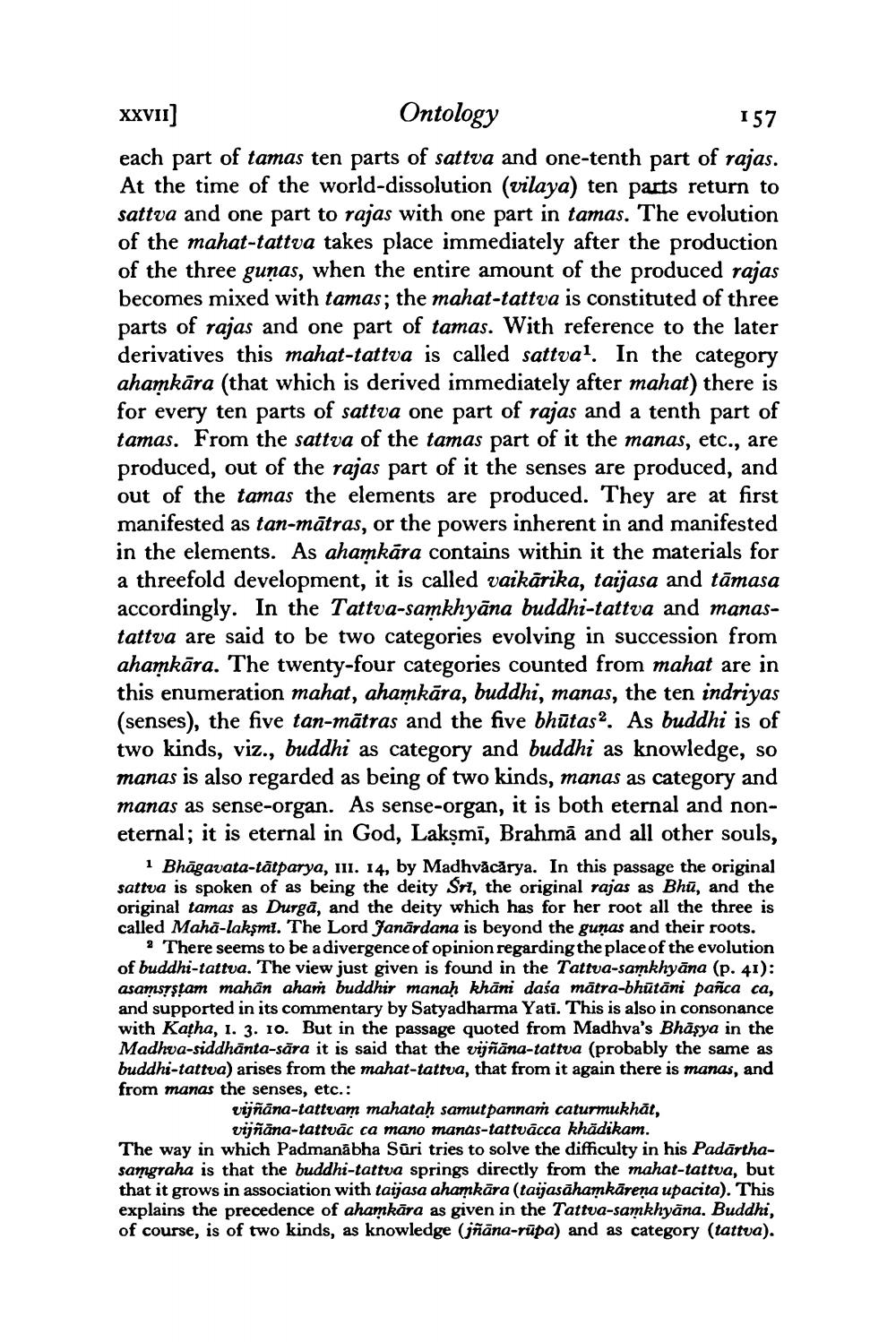________________
XXVII] Ontology
157 each part of tamas ten parts of sattva and one-tenth part of rajas. At the time of the world-dissolution (vilaya) ten parts return to sattva and one part to rajas with one part in tamas. The evolution of the mahat-tattva takes place immediately after the production of the three guņas, when the entire amount of the produced rajas becomes mixed with tamas; the mahat-tattva is constituted of three parts of rajas and one part of tamas. With reference to the later derivatives this mahat-tattva is called sattva?. In the category ahamkāra (that which is derived immediately after mahat) there is for every ten parts of sattva one part of rajas and a tenth part of tamas. From the sattva of the tamas part of it the manas, etc., are produced, out of the rajas part of it the senses are produced, and out of the tamas the elements are produced. They are at first manifested as tan-mātras, or the powers inherent in and manifested in the elements. As ahamkāra contains within it the materials for a threefold development, it is called vaikärika, taijasa and tāmasa accordingly. In the Tattva-samkhyāna buddhi-tattva and manastattva are said to be two categories evolving in succession from ahamkāra. The twenty-four categories counted from mahat are i this enumeration mahat, ahamkāra, buddhi, manas, the ten indriyas (senses), the five tan-mātras and the five bhūtas?. As buddhi is of two kinds, viz., buddhi as category and buddhi as knowledge, so manas is also regarded as being of two kinds, manas as category and manas as sense-organ. As sense-organ, it is both eternal and noneternal; it is eternal in God, Laksmi, Brahma and all other souls,
1 Bhāgavata-tātparya, 111. 14, by Madhvăcărya. In this passage the original sattva is spoken of as being the deity Sri, the original rajas as Bhū, and the original tamas as Durgă, and the deity which has for her root all the three is called Mahā-laksmi. The Lord Janārdana is beyond the gunas and their roots. 2 There seems to be a divergence of opinion regarding the place of the evolution
Th e Poding the of buddhi-tattva. The view just given is found in the Tattva-samkhyāna (p. 41):
price : asamststam mahan aham buddhir manah khāni daśa mātra-bhūtāni pañca ca, and supported in its commentary by Satyadharma Yati. This is also in consonance with Katha, 1. 3. 10. But in the passage quoted from Madhva's Bhāşya in the Madhva-siddhānta-sāra it is said that the vijñāna-tattva (probably the same as buddhi-tattva) arises from the mahat-tattva, that from it again there is manas, and from manas the senses, etc.:
vijñāna-tattvam mahatah samut pannam caturmukhāt,
vijñāna-tattuāc ca mano manas-tattuācca khädikam. The way in which Padmanabha Sūri tries to solve the difficulty in his Padārthasamgraha is that the buddhi-tattva springs directly from the mahat-tattua, but that it grows in association with taijasa ahamkāra (taijasahamkāreņa upacita). This explains the precedence of ahamkāra as given in the Tattva-samkhyāna. Buddhi, of course, is of two kinds, as knowledge (jñāna-rupa) and as category (tattva).




